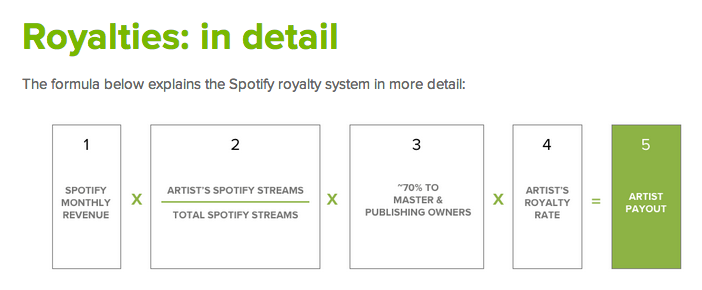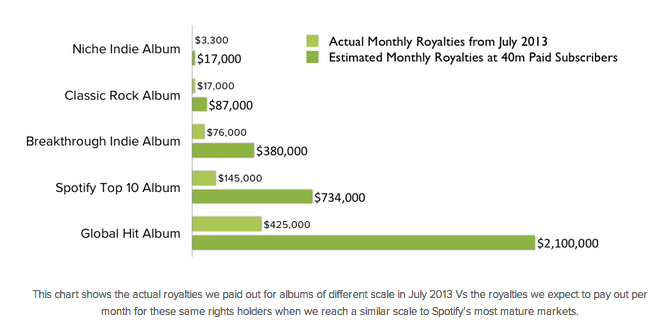
In an attempt to ease its strained relationship with musicians, Spotify has opened the books on its streaming music revenues—a little bit, at least. The Swedish on-demand music service and its peers tend to flail when pressed to answer how exactly the streaming service is good for the vast majority of musicians who stock its expansive sonic catalogue.
See also: 6 Million People Pay For Spotify—Is That Good Enough?
In an effort to cozy up to disgruntled music makers the world over, Spotify has introduced “Spotify for Artists,” a portal filled with resources for the musician on the other side of the stream. Spotify for Artists outlines best practices for the platform and offers a cool new artist-centric analytics tracker in partnership with music analytics group Next Big Sound.
Most important of all, it dives into great detail about what makes Spotify’s business model go ‘round, how the company’s considerable revenues will benefit musicians—and when.

Spotify’s newly released statistics have plenty of interesting, previously veiled tidbits:
- Spotify had over 24 million global users in March 2013. 18 million Spotify users stick to its free tier, supported by ads. More than 6 million users pay $9.99 per month to subscribe to Spotify’s premium tier.
- The company pays out over 70% of its total revenue to rights holders who “split amongst the rights holders in accordance with the popularity of their music on the service. The label or publisher then divides these royalties and accounts to each artist depending on their individual deals.”
- Averaged across its free and premium tiers, Spotify pays out between $.006 and $.0084 each time a track is streamed. (Yes, that’s an average that somehow yielded a range of values. That’s Spotify for you.)
- In July 2013, an example “niche indie album” earned a payout of $3,300, compared to a “breakthrough indie album” that earned $76,000. A “global hit album” (think Adele-level level megahits) earned $425,000 in the same month.
- Between 2012 and 2013, Spotify doled out over $3 million to an anonymous “global star.” Other major artists were paid out over $3 million in the same year.

Spotify goes on to toot its own horn about precipitating a decline in piracy, which isn’t unfounded. (With streaming media at our fingertips these days, why bother hunting down a P2P torrent?) The company insists that while its 18 million-strong userbase may be small—by contrast, Pandora boasts over 200 million registered users—it’s growing fast. And when its experimental business model starts scaling up, to 40 million paid users, to be specific, artist payouts will more than quadruple.
The only problem? They’re still 34 million paid users shy.
Streaming Music Isn’t Working For Anyone (Except Consumers)
If most listeners aren’t particularly aware of just how raw the deal is for the artists that they love to stream, it’s no surprise. Even with recent high profile flare ups like the spat between Pandora and Pink Floyd—which aired its opinion of Pandora’s proposal to further skimp on artist royalties in USA Today—streaming music companies continue to defend a business model that isn’t working for much of anyone. Pandora and Spotify both face widening losses, sagging under the heavy price of borrowing the music that powers both products.
Spotify raked in around $578 million in 2012, but continues to dole out the majority of its revenues in licensing fees. To date, Spotify, like Pandora, has yet to make a profit. Whether it can continue to grow its user base to that magic 40 million number while placating rightfully pissed-off musicians remains to be seen. It’s an uphill trek, particularly if those same musicians successfully spread their gospel—calling for a boycott on Spotify and other streaming services—to their loyal fans. Overcoming that cognitive dissonance is a daily activity for regular Spotify and Pandora listeners aware of the tensions between musicians and this crop of still unprofitable streaming music overlords.
Personally, I didn’t so much as pause my Spotify premium account in the course of writing this story. I’m sort of sorry about being such an avid streaming listener… but not sorry enough to unsubscribe.
Lead image by Taylor Hatmaker for ReadWrite










